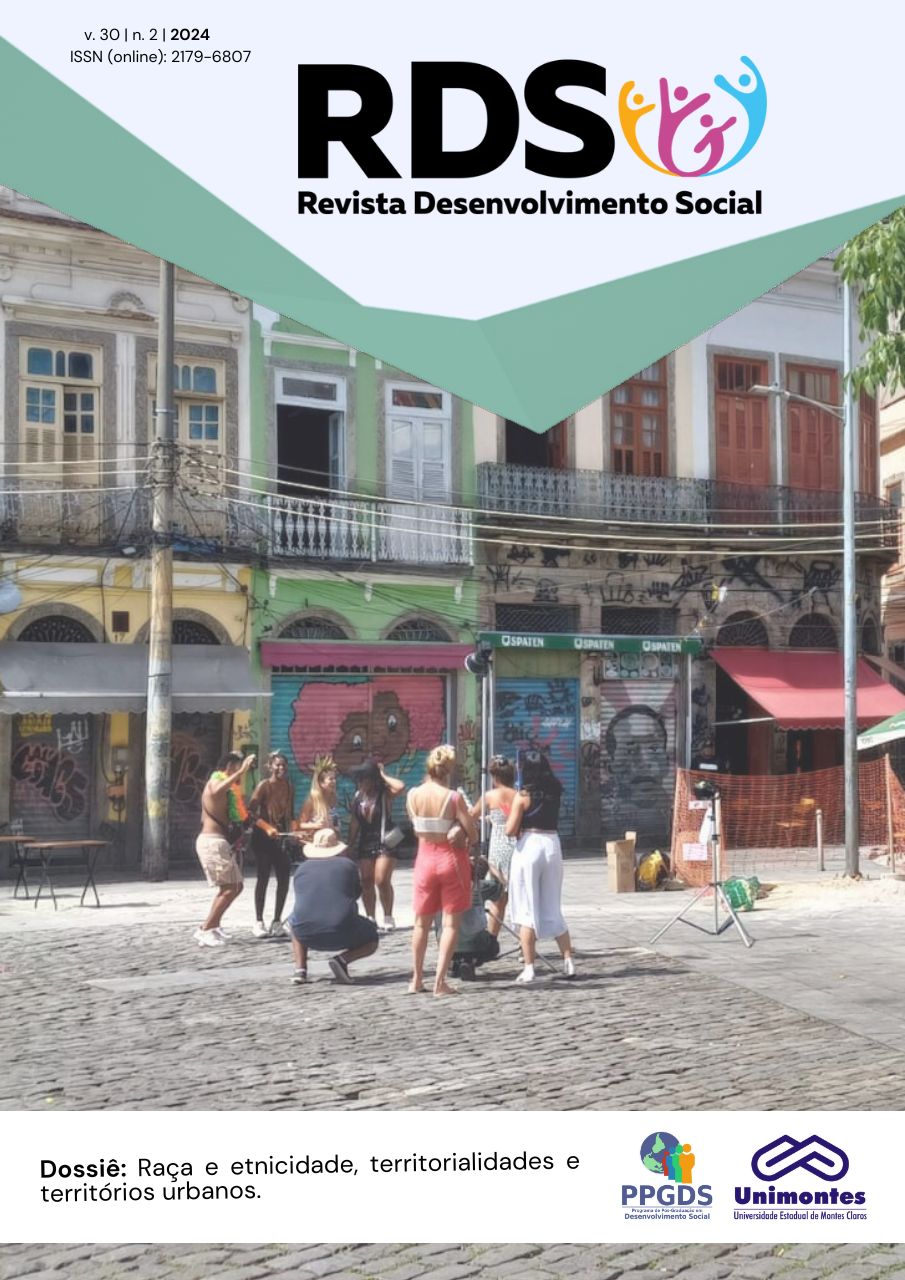ANCESTRAL ETHNIC TERRITORIES: COSMOPOLITICS OF NATURE
ANCESTRAL ETHNIC TERRITORIES: COSMOPOLITICS OF NATURE
DOI:
https://doi.org/10.46551/issn2179-6807v30n2p73-91Keywords:
Cosmopolíticas da Natureza., Territórios Étnicos Ancestrais, Justiça Socioambiental, Urbanidade Florestal., Cartografia Social.Abstract
This article investigates how nature's cosmopolitics and ancestral ethnic territories offer new perspectives for socio-environmental justice and urbanism. It emphasizes the importance of integrating Indigenous and traditional knowledge into discussions on urbanization and sustainable development, highlighting the symbiotic relationship between nature and humans as an alternative to hegemonic and capitalist approaches, which view nature as a commodity. Social cartography is presented as a tool of resistance, allowing Indigenous and traditional communities to appropriate space and build territories according to their cosmologies. The concept of "forest urbanity" proposes a reconfiguration of cities, inspired by Indigenous practices of harmonious coexistence with nature. The article also discusses how the cultural and spiritual practices of these communities are often ignored in conservation policies, leading to socio-environmental conflicts, especially in protected areas. However, the integration of concepts like "Buen Vivir" and the valorization of sacred natural sites are pointed out as pathways to more just and environmentally balanced cities. In conclusion, the text argues that recognizing ancestral ethnic territories and their cosmopolitics as legitimate forms of knowledge production can transform urbanism, promoting social justice, environmental equity, and sustainability.
Downloads
References
ACSELRAD, Henri (org.). Cartografias sociais e território. Rio de Janeiro: Universidade Federal do Rio de Janeiro, Instituto de Pesquisa e Planejamento Urbano e Regional, 2008. 168 p. (Coleção Território, Ambiente e Conflitos Sociais, n. 1).
ALMEIDA, Alfredo Wagner Berno de; NOVA CARTOGRAFIA SOCIAL DA AMAZÔNIA. Projeto Nova Cartografia Social da Amazônia. Manaus: Universidade do Amazonas, 2005. Disponível em: http://novacartografiasocial.com.
BENZEEV, Rayna et al. Formalizing tenure of Indigenous lands improved forest outcomes in the Atlantic Forest of Brazil. PNAS Nexus, v. 2, n. 1, 2023. Disponível em: https://doi.org/10.1073/pnasnexus.pgac287. Acesso em: 14 set. 2024.
BHUSHAN, Chandra. A Mountain of Conflict: India’s Battle to Save Niyamgiri Hills. Nova Deli: Centre for Science and Environment, 2013.
BODISATVA. Terra é de Nhanderu. Revista Bodisatva, [S.l.], 2022. Disponível em:
https://bodisatva.com.br/terra-e-de-nhanderu/. Acesso em: 09 set. 2024.
BOYD, David R. The Rights of Nature: A Legal Revolution That Could Save the World. Toronto: ECW Press, 2017.
CALVO, Daniela. O terreiro de candomblé como espaço de construção do sagrado e de materialização da memória ancestral. REVER: Revista de Estudos da Religião, v. 19, n. 2, p. 253-270, 2019.
CANÇADO, Wellington. Urbanidades de outras naturezas. In: COSTA, G.; COSTA, H.; VELLOSO, R.; MONTE-MÓR, R. (Org.). Teoria e práticas urbanas: caminhos. 2. ed. Belo Horizonte: Cosmópolis, 2024. 2 v.
DE LA PEÑA, Guillermo. Territorio y ciudadanía étnica en la nación globalizada. Desacatos, n. 1, p. 1-16, 1999.
DE SOUSA, Adriano Amaro. Território e identidade: elementos para a identidade territorial. Caderno Prudentino de Geografia, v. 1, n. 30, p. 119-132, 2008.
GUDYNAS, Eduardo. Buen Vivir: today's tomorrow. Development, v. 54, n. 4, p. 441–447, 2011. Disponível em: https://doi.org/10.1057/dev.2011.86.
HARAWAY, Donna. Ficar com o problema: fazer parentes no Cthuluceno. São Paulo: Editora n-1, 2023.
HARLEY, J. B. Deconstructing the map. Cartographica: The International Journal for Geographic Information and Geovisualization, v. 26, n. 2, p. 1-20, 1995.
HUTCHISON, Andrew. The Whanganui River as a Legal Person. Victoria University of Wellington Law Review, v. 49, n. 1, p. 1-30, 2018.
KOPENAWA, Davi; ALBERT, Bruce. A queda do céu: palavras de um xamã yanomami. São Paulo: Companhia das Letras, 2019.
KRENAK, Ailton. O amanhã não está à venda. São Paulo: Companhia das Letras, 2022.
LATOUR, Bruno. Políticas da natureza: como trazer as ciências de volta à democracia. São Paulo: Editora UNESP, 2004.
LEWANDOWSKI, Andressa; DOS SANTOS, Julia Otero. Cosmopolíticas na terra: produção de lugares e os limites da territorialização. Ilha Revista de Antropologia, v. 21, n. 1, p. 005-020, 2019.
LOVELOCK, James. Gaia: Um novo olhar sobre a vida na Terra. São Paulo: Intrínseca, 2020.
LYNCH, Barbara Deutsch. Marking Territory and Mapping Development. 6th Annual Conference of the International Association for the Study of Common Property. Berkeley, CA, 1996.
MALCHER, Lucia. Quilombos contemporâneos: espaços de resistência cultural e política. Revista Brasileira de Ciências Sociais, v. 24, n. 71, p. 27-44, 2009.
MIESENBERGER, Caren. Resistência contra hidrelétricas no Rio Tapajós. Fundação Heinrich Böll, 2015. Disponível em: https://br.boell.org/pt-br/2015/06/11/resistencia-contra-hidreletricas-no-rio-tapajos. Acesso em: 19 dez. 2024.
MONDARDO, Marcos. Geografias indígenas e territórios ancestrais. Revista Tocantinense de Geografia, v. 12, n. 26, p. 145-176, 2023.
PADEL, Felix; DAS, Samarendra. Out of This Earth: East India Adivasis and the Aluminium Cartel. Orient BlackSwan, 2010.
SIMARD, Suzanne. Finding the Mother Tree: Discovering the Wisdom of the Forest. New York: Knopf, 2021.
STENGERS, Isabelle. A proposição cosmopolítica. Revista do Instituto de Estudos Brasileiros, n. 68. 2017. Disponível em: https://www.revistas.usp.br/rieb/article/view/145663. Acesso em: 4 mar. 2024.
VIANNA, Aurélio. Cartografia social e direitos territoriais. In: ACSELRAD, Henri (org.). Cartografias sociais e território. Rio de Janeiro: Universidade Federal do Rio de Janeiro, Instituto de Pesquisa e Planejamento Urbano e Regional, 2008.
Published
How to Cite
Issue
Section
Categories
License
Copyright (c) 2025 Pedro Henrique Azalim Cunha

This work is licensed under a Creative Commons Attribution-NonCommercial-NoDerivatives 4.0 International License.
Esta licença permite que outros(as) façam download do trabalho e o compartilhe desde que atribuam crédito ao autor(a), mas sem que possam alterá-lo de nenhuma forma ou utilizá-lo para fins comerciais.












.png)
.png)




.png)









